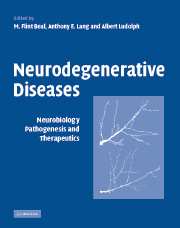Book contents
- Frontmatter
- Contents
- List of contributors
- Preface
- Part I Basic aspects of neurodegeneration
- Part II Neuroimaging in neurodegeneration
- Part III Therapeutic approaches in neurodegeneration
- Normal aging
- Part IV Alzheimer's disease
- Part VI Other Dementias
- Part VII Parkinson's and related movement disorders
- 37 Approach to the patient presenting with parkinsonism
- 38 Parkinson's disease
- 39 Neuropathology of Parkinson's disease
- 40 Genetics of parkinsonism
- 41 Pathophysiology: biochemistry of Parkinson's disease
- 42 Current and potential treatments of Parkinson's disease
- 43 Multiple system atrophy
- 44 Progressive supranuclear palsy
- 45 Corticobasal degeneration
- Part VIII Cerebellar degenerations
- Part IX Motor neuron diseases
- Part X Other neurodegenerative diseases
- Index
- References
44 - Progressive supranuclear palsy
from Part VII - Parkinson's and related movement disorders
Published online by Cambridge University Press: 04 August 2010
- Frontmatter
- Contents
- List of contributors
- Preface
- Part I Basic aspects of neurodegeneration
- Part II Neuroimaging in neurodegeneration
- Part III Therapeutic approaches in neurodegeneration
- Normal aging
- Part IV Alzheimer's disease
- Part VI Other Dementias
- Part VII Parkinson's and related movement disorders
- 37 Approach to the patient presenting with parkinsonism
- 38 Parkinson's disease
- 39 Neuropathology of Parkinson's disease
- 40 Genetics of parkinsonism
- 41 Pathophysiology: biochemistry of Parkinson's disease
- 42 Current and potential treatments of Parkinson's disease
- 43 Multiple system atrophy
- 44 Progressive supranuclear palsy
- 45 Corticobasal degeneration
- Part VIII Cerebellar degenerations
- Part IX Motor neuron diseases
- Part X Other neurodegenerative diseases
- Index
- References
Summary
Introduction
Progressive supranuclear palsy (PSP) is unusual among the neurodegenerative disorders in the variety of neural structures it involves and the complexity of the illness that results. The tau-based neurofibrillary tangles and the associated degeneration affect both neurons and glia. The damage involves systems at every level from cerebral cortex to lumbar spinal cord. It affects dopaminergic, cholinergic and GABAergic systems. Its superficial clinical resemblance to Parkinson's disease (PD) and close pathological resemblance to postencephalitic parkinsonism delayed its definitive clinicopathological description until the early 1960s. (Richardson, 1963; Olszewski, 1963; Steele et al., 1964). Its full-blown, typical clinical appearance is unmistakable, but atypical forms are frequent and multiple conditions can mimic it.
The etiology of PSP is no clearer than that of most other neurodegenerative disorders but the late 1990s have brought important new insights into the molecular defects underlying neurofibrillary tangle formation. Such insights will probably prove the best route to treatment of PSP, as symptomatic palliative treatments have been disappointing.
Clinical summary
Presentation
In its full-blown, typical state, PSP will not be confused with other illnesses. There can be little diagnostic doubt in a patient with a progressive syndrome of gait instability with early falls, neck rigidity with erect posture and bradykinesia, predominantly vertical supranuclear gaze abnormality, spastic dysarthria, dangerous dysphagia, tonically contracted facies and frontal behavioral abnormalities.
Restriction of vertical gaze with preserved oculocephalic reflexes is the most specific feature of PSP and the source of its name.
- Type
- Chapter
- Information
- Neurodegenerative DiseasesNeurobiology, Pathogenesis and Therapeutics, pp. 663 - 681Publisher: Cambridge University PressPrint publication year: 2005
References
- 6
- Cited by

